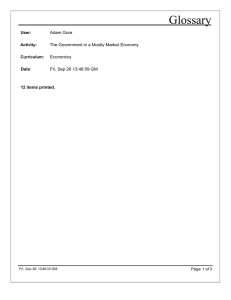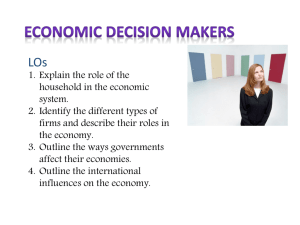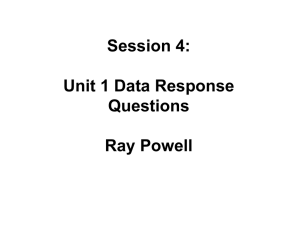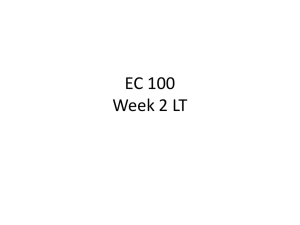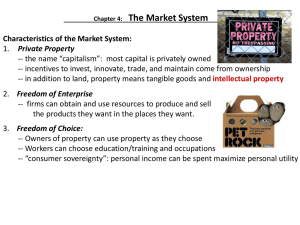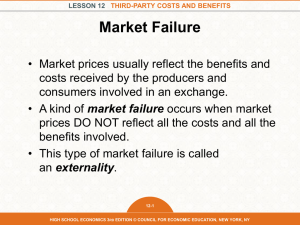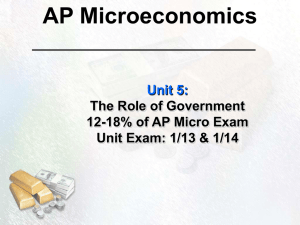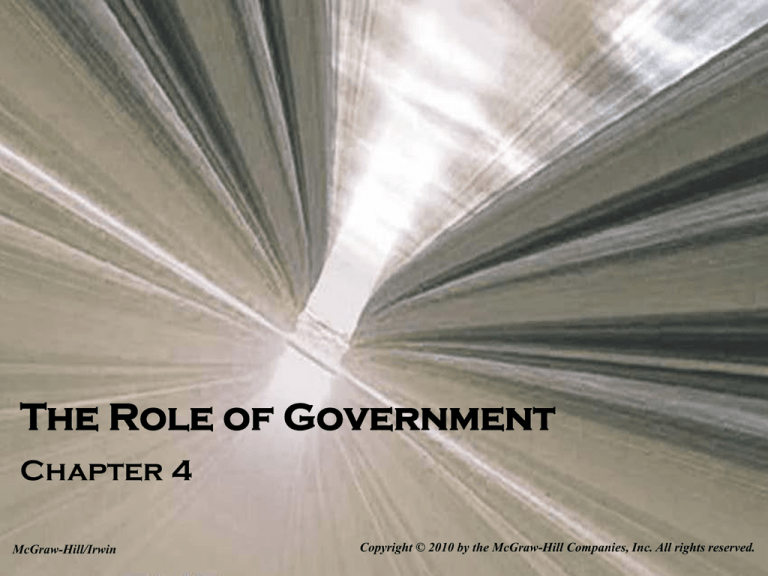
The Role of Government
Chapter 4
McGraw-Hill/Irwin
Copyright © 2010 by the McGraw-Hill Companies, Inc. All rights reserved.
Government’s Role
• When markets fail government intervention
may be needed
– Under what circumstances do markets fail?
– How can government intervention help?
– How much government intervention is desirable?
4-2
Market Failure
• Ideally, the market mechanism leads to an
optimal mix of output
• Optimal mix of output: The most desirable
combination of output attainable with existing
resources, technology and social values
4-3
Market Failure
• The market mechanism uses market prices
and sales to signal desired outputs (or resource
allocations)
• Market failure: An imperfection in the
market mechanism that prevents optimal
outcomes
4-4
Market Failure
• When there is market failure the forces of
supply and demand don’t lead to the optimal
point on the production possibilities curve
• There is a basis for government intervention to
push market outcomes closer to the ideal
4-5
Computers (units per time period)
Market Failure
Production
possibilities
X (Optimal mix)
M (Market mix)
All Other Goods (units per time period)
4-6
Causes of Market Failure
• The four specific sources of market failure are:
–
–
–
–
Public goods
Externalities
Market power
Equity
4-7
Public Goods
• Private good: A good or service whose
consumption by one person excludes
consumption by others
• Public good: A good or service whose
consumption by one person does not exclude
consumption by others
4-8
The Free-Rider Dilemma
• The communal nature of public goods may
cause some consumers to try for a free ride
• Free rider: An individual who reaps direct
benefits from someone else’s purchase
(consumption) of a public good
4-9
Underproduction of Public Goods
• If public goods were marketed like private
goods, everyone would wait for someone else
to pay
• Consequently, the market under-produces
public goods and over-produces private goods
• Need government intervention to remedy
4-10
Externalities
• Externalities: Costs (or benefits) of a market
activity borne by a third party; the difference
between the social and private costs (benefits)
of a market activity
• When externalities are present, market prices
are not a valid measure of a good’s value to
society
4-11
External Costs and Benefits
Social Demand Market Demand Externalities
– Subtract external costs, a negative impact
– Add external benefits, a positive impact
• The optimal production mix is where the social
demand curve intersects the supply curve
4-12
Externalities
Price (per pack)
Market supply
EM
EO
External cost
per pack
Market
demand
Optimal
output
Market
output
qO
Social demand
qM
Quantity of Cigarettes (packs per year)
4-13
External Costs and Benefits
• The market fails by:
– Over-producing goods that have external costs
– Under-producing goods that have external benefits
• To move toward the optimal mix, we need
government intervention
4-14
Market Power
• The market may fail when the response to
price signals is flawed, rather than the signals
themselves
• Market power: The ability to alter the market
price of a good or service
4-15
Restricted Supply
• Market power gives a producer the ability to
maximize profits rather than produce the
optimal mix of output
• Monopoly: A firm that produces the entire
market supply of a particular good or service
4-16
Antitrust Policy
• Government intervention is necessary to
prevent or dismantle concentrations of market
power
• Antitrust: Government intervention to alter
market structure or prevent abuse of market
power
4-17
Natural Monopoly
• A monopoly structure may be desirable
• Natural monopoly: An industry in which one
firm can achieve economies of scale over the
entire range of market supply
• Government may need to regulate the behavior
of a natural monopoly
4-18
Inequity
• The marketplace distribution of goods and
services is not necessarily “fair”
• Taxes and transfers are the principal tools for
redistributing income
• Transfer Payments: Payments to individuals
for which no current goods or services are
exchanged
4-19
Merit Goods
• Merit good: A good or service society deems
everyone is entitled to some minimal quantity
of
• Government steps in to provide merit goods
when market outcomes are inadequate
4-20
Macro Instability
• Micro market failures imply we are at the
wrong point on the production-possibilities
curve or inequitably distributing output
• The marketplace also experiences bouts of
unemployment and inflation, which require
government intervention at the macro level
4-21
Macro Instability
• Unemployment: The inability of labor-force
participants to find jobs
• Inflation: An increase in the average level of
prices of goods and services
4-22
Macro Instability
• The goal of macro intervention is to foster
economic growth
– Achieve full employment
– Maintain stable prices
– Increase production capacity
4-23
Growth of Government
• Potential micro and macro market failures
justify government intervention
• The public sector has increased dramatically
– In 1902 the U.S. government employed fewer than
350,000 people and spent only $650 million
– Today the federal government employs nearly 4
million people and spends about $4 trillion a year
4-24
Federal Growth
• Although the absolute size of government has
grown, the relative size of government – direct
expenditures on government purchases as a
share of total output – has declined
• Virtually all recent growth in overall federal
expenditures has come from increased income
transfers, not purchases of goods and services
4-25
Government Growth
Source: U.S. Bureau of Economic Analysis
During World War II the public sector purchased nearly half of total U.S.
output. Since the early 1950s the public-sector share of total output has been
closer to 20 percent.
4-26
State and Local Growth
• The share of public-sector spending attributed
to different levels of government has changed
– State and local spending dominated until World
War II, when the federal share overtook it
– In the 1960s state and local spending caught up
– Today state and local governments buy much more
output and employ many more people
4-27
Taxation
• The opportunity cost of government spending
is the private-sector output sacrificed
• The primary function of taxes is to transfer
command over resources (purchasing power)
from the private sector to the public sector
4-28
Federal Taxes
• Federal government revenue sources include
–
–
–
–
Income taxes
Social security taxes
Corporate taxes
Excise taxes
4-29
Income Taxes
• Individual income taxes are the largest single
source of federal government revenue
• Progressive tax: A tax system in which tax
rates rise as incomes rise
• People with high incomes pay more taxes and
pay a larger fraction of their income in taxes
4-30
Social Security Taxes
• Current workers transfer a portion of earnings
to retirees through mandatory deductions
• The social security tax is proportional up to a
certain income ceiling and regressive after that
– Proportional tax: A tax that levies the same rate
on every dollar of income
– Regressive tax: A tax system in which tax rates
fall as income rises
4-31
Corporate Taxes
• The federal government taxes the profits of
corporations as well as consumer incomes
• Corporate taxes are a relatively small source of
revenue
4-32
Excise Taxes
• Excise taxes are imposed on certain goods and
services, including such things as liquor,
gasoline, and cigarettes
• Excise taxes discourage production and
consumption of these goods
4-33
Federal Taxes
Source: Office of Management and Budget, FY2010 data
4-34
State and Local Revenues
• In general, cities depend heavily on property
taxes and state governments rely heavily on
sales taxes
• State and local taxes tend to be regressive
4-35
Government Failure
• The goal of government intervention is to
change the mix of output
• Government failure: Government
intervention that fails to improve economic
outcomes
4-36
Perceptions of Waste
• Government waste is when the public sector
isn’t producing as many services as it could
with given resources
• Such inefficiency implies production inside the
production-possibilities curve
4-37
Opportunity Cost
• The issue of government waste encompasses
two distinct questions:
– Efficiency: Are we getting as much as we could
from the resources we allocate to government?
– Opportunity cost: Are we giving up too many
private-sector goods in order to get those services?
4-38
Cost-Benefit Analysis
• Additional public-sector activity is desirable
only if the benefits from that activity exceed
the opportunity costs
• The value (benefits) of public services must be
estimated because they don’t have (reliable)
market prices
4-39
Ballot-Box Economics
• Voting mechanisms substitute for the market
mechanism in allocating resources to the
public sector and deciding how to use them
• We do not know what the real demand for
public goods is, and votes alone do not reflect
the intensity of individual demands
4-40
Public Choice Theory
• Public choice: Theory of public-sector
behavior emphasizing rational self-interest of
decision-makers and voters
• A central tenet of public-choice theory is that
bureaucrats are just as selfish (utility
maximizing) as everyone else
4-41
The Role of Government
End of Chapter 4
McGraw-Hill/Irwin
Copyright © 2010 by the McGraw-Hill Companies, Inc. All rights reserved.



